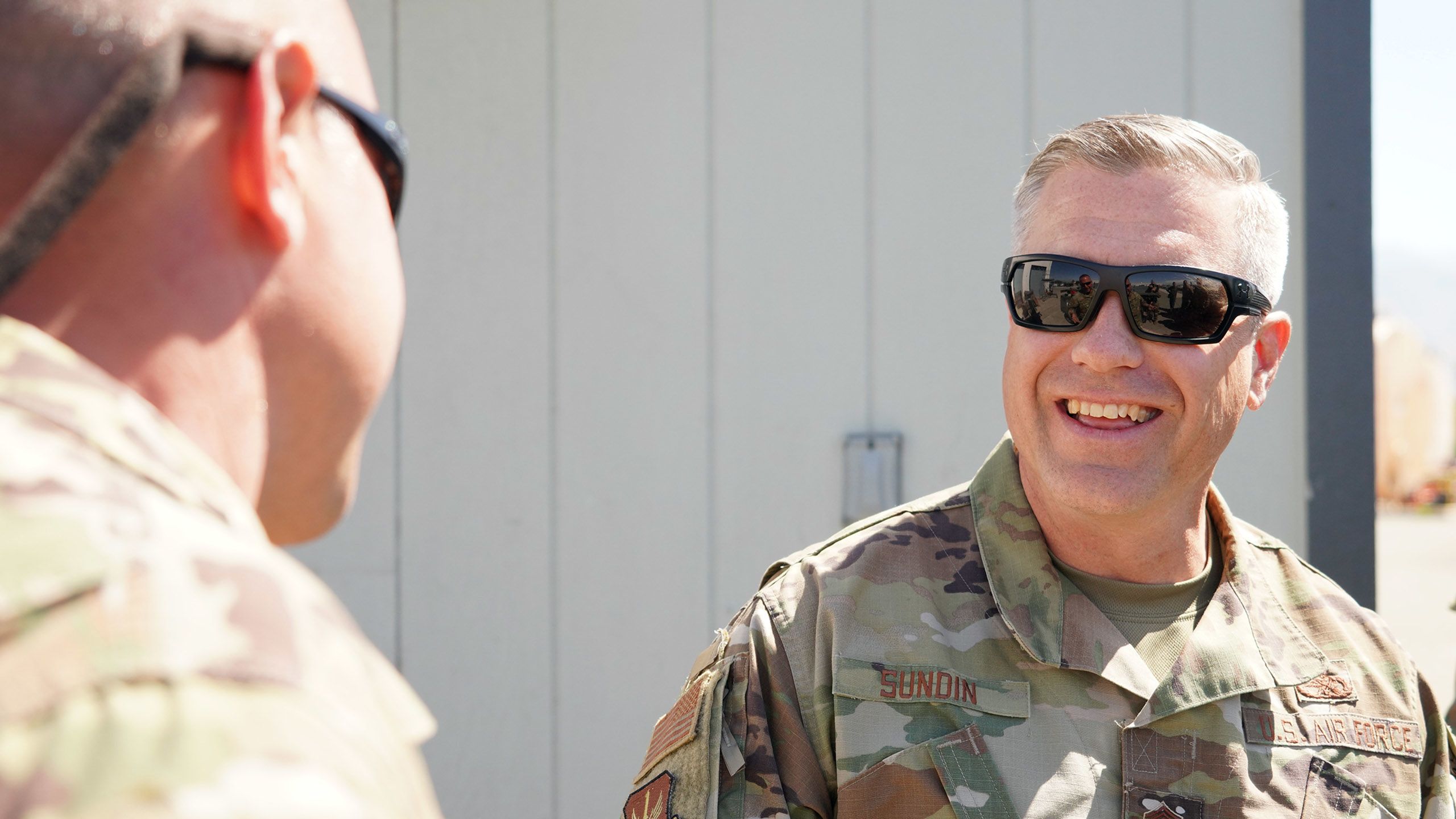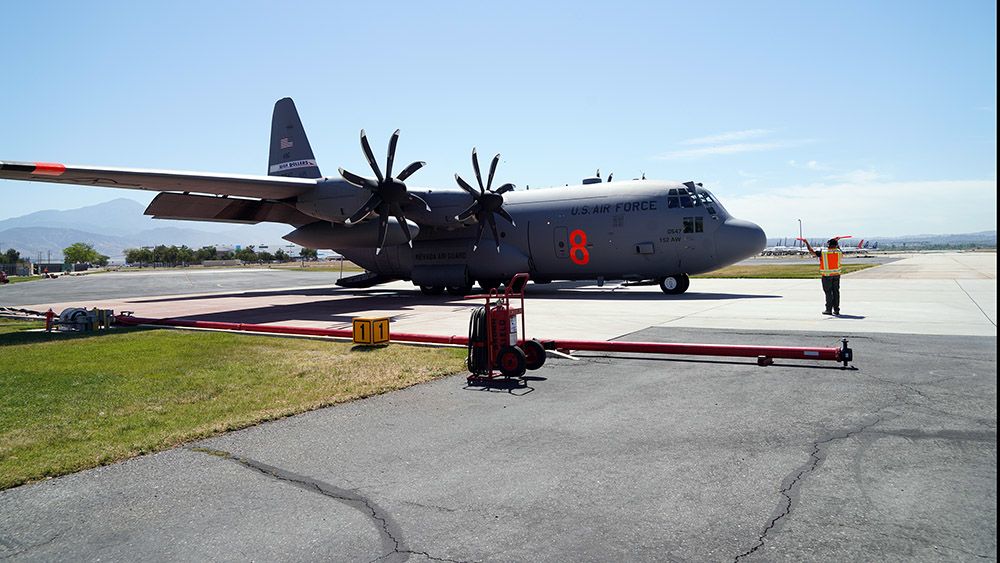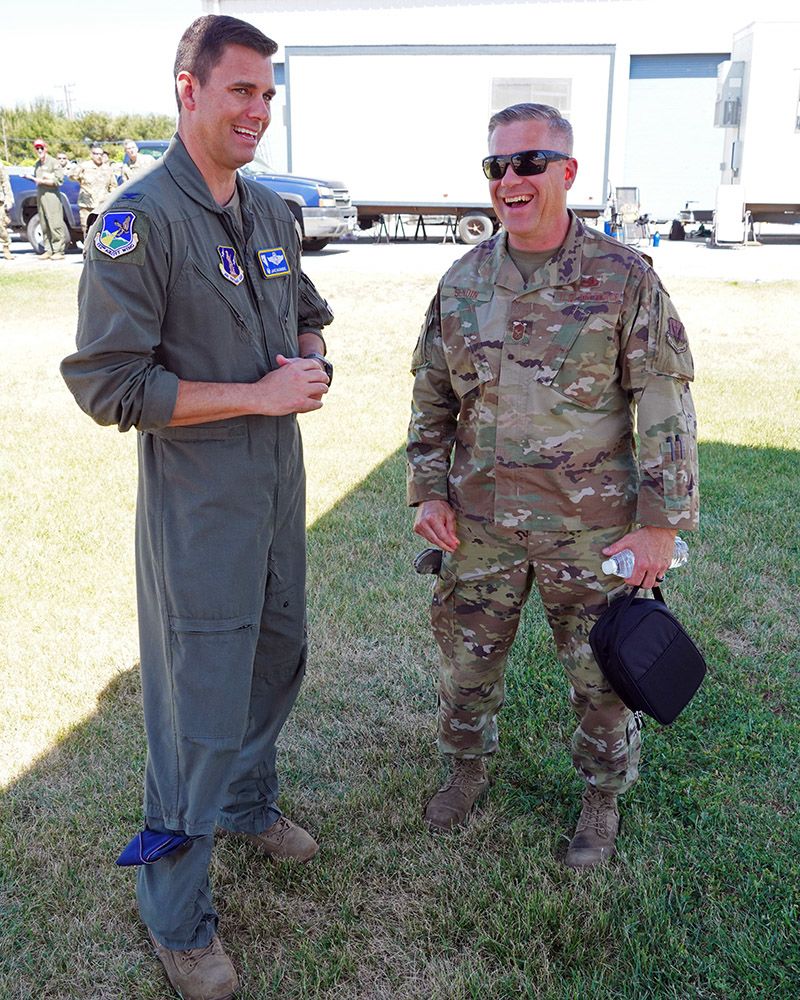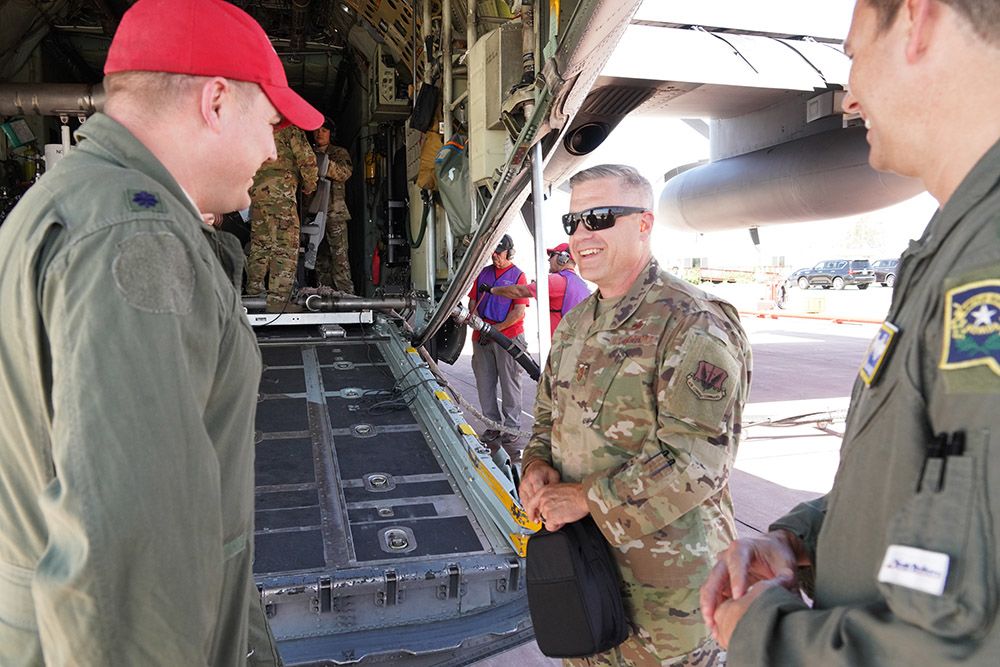1st Air Force leaders visit MAFFS training
Senior leaders observe annual wildfire aviation training between Guard and U.S. Forest Service.

by Lt. Col. Chris Lowe
146th Airlift Wing Public Affairs
May 6, 2021
SAN BERNARDINO, Calif. – Four C-130 aircraft from the California and Nevada Air National Guard worked alongside the U.S. Forest Service during annual refresher and certification training with the Modular Airborne Fire Fighting System (MAFFS) May 4-7 in San Bernardino.
During the training, these aircraft equipped with MAFFS units practice dispersing water in rugged, mountainous terrain, as they are guided by lead planes flown by members of the U.S. Forest Service.
The MAFFS system is a self-contained unit that is loaded into the belly of the C-130 Hercules aircraft, allowing for 3,000 gallons of fire retardant to be strategically placed ahead of fire lines to stop wildfires from progressing.The 146th Airlift Wing, based out of Port Hueneme, and the 152nd Airlift Wing, based out of Reno, Nevada, worked to hone their skills in this specialized flying mission.
U.S. Air Force Command Chief Master Sgt. Mikael “Mack” Sundin, of the Continental U.S. North American Aerospace Command Region, 1st Air Force (Air Forces Northern), visited Southern California to observe this training firsthand.
According to Sundin, the importance of sustaining a robust aerial firefighting force is not lost among the top brass in Washington.
“The C-130 fleet is an invaluable asset to the protection of life and property that we should all be proud of. From an AFNORTH perspective, Defense Support to Civil Authorities is a top priority,” said Sundin.
“While it’s hard to predict such things as pandemics, wildfires remain a constant. A year-round discussion on activating MAFFS when called upon sits high on the list; we never want another fire season like we had last year,” Sundin said.
MAFFS operations involve constant, ever-changing logistics and communications between Air National Guard and Reserve members and supporting agencies because of the unpredictable nature of fires and the weather conditions caused by the fires themselves.
According to Sundin, the National Defense Strategy, as dictated by the president, stresses its number one priority, homeland defense. This comes with many different layers and defense support to civil authorities is certainly one of those layers.
“The prevention of loss of life and damage to property is one of the Guard’s main focuses. Without this aerial firefighting capability and our partnerships with all the firefighting agencies like the U.S. Forest Service, we wouldn’t be properly defending the homeland,” said Sundin. “Swiftly helping our fellow citizens when disaster strikes is key for a more resilient nation.”
“I assure you that MAFFS will remain relevant for the foreseeable future. We remain committed to our military members and our neighbors.”
Impressed with the professionalism and strict adherence to safety measures between the Airmen and U.S. Forest Service members training during the week-long certification, Sundin reiterated his admiration for the aerial fire-fighting agencies that the Air National Guard and Reserve units work to support, and for the dedication of the Airmen themselves.
“This is the perfect mission for the Air National Guard and all of the firefighting agencies involved with this mission. They define the way it should be done. MAFFS doesn’t come with just one specific wing or agency; we all work together well as one team.”
The 153rd Airlift Wing from Cheyenne, Wyoming, and the 302nd Airlift Wing located at Peterson Air Force Base, Colorado, are also part of the Air Expeditionary Group MAFFS program and will conduct their certification training in Colorado.

U.S. Air Force Chief Master Sgt. Mikael Sundin, Command Chief Master Sgt. of 1st Air Force, tours a C130-E Hercules aircraft from the Nevada Air National Guard's 152nd Airlift Wing during Modular Airborne Fire Fighting System training at the San Bernardino Air Tanker Base, in San Bernardino, May 5. Utilizing C-130 aircraft equipped with a MAFFS unit, Airmen from California and Nevada trained alongside the U.S. Forest Service and other wildfire prevention agencies. (U.S. Air National Guard photo by Senior Airman Michelle Ulber)
U.S. Air Force Chief Master Sgt. Mikael Sundin, Command Chief Master Sgt. of 1st Air Force, tours a C130-E Hercules aircraft from the Nevada Air National Guard's 152nd Airlift Wing during Modular Airborne Fire Fighting System training at the San Bernardino Air Tanker Base, in San Bernardino, May 5. Utilizing C-130 aircraft equipped with a MAFFS unit, Airmen from California and Nevada trained alongside the U.S. Forest Service and other wildfire prevention agencies. (U.S. Air National Guard photo by Senior Airman Michelle Ulber)
“The prevention of loss of life and damage to property is one of the Guard’s main focuses. Without this aerial fire-fighting capability and our partnerships with all the firefighting agencies like the U.S. Forest Service, we wouldn’t be properly defending the homeland.”

U.S. Air Force Chief Master Sgt. Mikael Sundin, Command Chief Master Sgt. of 1st Air Force, talks to an aircrew member during MAFFS training, May 5, in San Bernardino. (U.S. Air National Guard photo by Senior Airman Michelle Ulber)
U.S. Air Force Chief Master Sgt. Mikael Sundin, Command Chief Master Sgt. of 1st Air Force, talks to an aircrew member during MAFFS training, May 5, in San Bernardino. (U.S. Air National Guard photo by Senior Airman Michelle Ulber)

U.S. Air Force Chief Master Sgt. Mikael Sundin, Command Chief Master Sgt. of 1st Air Force, tours a C130-E Hercules aircraft from the Nevada National Guard's 152nd Airlift Wing, based in Reno, Nevada, during Modular Airborne Fire Fighting System training in San Bernardino, May 5. (U.S. Air National Guard photo by Senior Airman Michelle Ulber)
U.S. Air Force Chief Master Sgt. Mikael Sundin, Command Chief Master Sgt. of 1st Air Force, tours a C130-E Hercules aircraft from the Nevada National Guard's 152nd Airlift Wing, based in Reno, Nevada, during Modular Airborne Fire Fighting System training in San Bernardino, May 5. (U.S. Air National Guard photo by Senior Airman Michelle Ulber)


